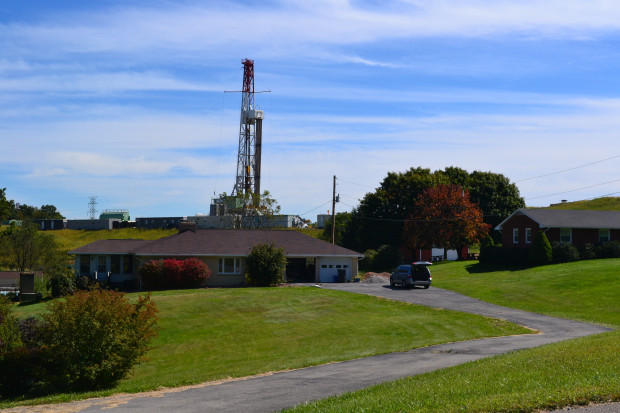Gas production increased in 2016, as number of new shale gas wells decreased

courtesy of FracTracker Alliance
A natural gas well behind a house in southwestern Pennsylvania. Gas production reached 5.1 trillion cubic feet in 2016.
Pennsylvania’s shale gas drillers continued to break records for production in 2016, tapping about 5.1 trillion cubic feet of natural gas. Although the increase in production was not as high as in previous years, it still represents an upward trend, while the number of new well permits are declining, according to data published this week by the Department of Environmental Protection. Pennsylvania still ranks second behind Texas in total volume of natural gas production.
The state’s annual oil and gas report is in electronic form for the first time as part of the department’s efforts to put more drilling data online in a publicly accessible format. It includes GIS information on well sites, and charts outlining trends over the past ten years.
“We encourage you to take some time, click through the map…and really dig into this information,” said acting DEP Secretary Patrick McDonnell in a video taped message on the new site.
The state has faced criticism in the past for not providing up to date information on well sites, which the public could easily access. The nonprofit organization FracTracker has used DEP data to create user friendly sites and analysis from the agency’s databases.
Brook Lenker, FracTracker’s executive director, says the DEP’s new site is a positive step.
“The more accessible, and the more transparent oil and gas data is made to the public, the better,” he said.
Drilling of new shale gas wells has been on the decline since 2014. The state issued permits for 1,321 wells in 2016. At the height of the shale gas drilling boom in 2011, DEP recorded 3,560 well permits.
For more shallow, conventional wells, the downward trend is even more significant. DEP granted 4,197 conventional well permits in 2009, and just 158 in 2016.
The agency says its inspections are on the rise. For both conventional non-shale gas wells, and unconventional shale wells, DEP inspectors made 35,556 visits in 2016, more than double the number of inspections conducted in 2010. And environmental violations resulted in record fines for 2016, totaling $9,688,573.00. The majority of those penalties resulted from just 9 significant incidents, according to the DEP.
The number of violations issued by DEP to shale gas drillers had been trending downward with a slight uptick in 2016. But conventional wells have seen a significant increase in sanctions, with 1,834 last year, up from 1,024 in 2015.
















